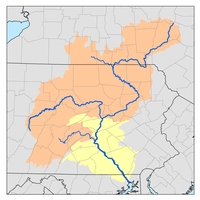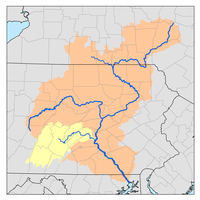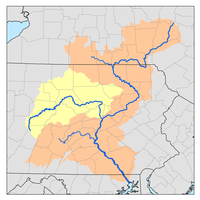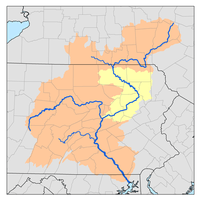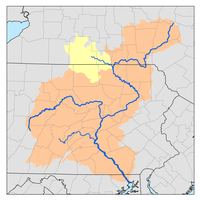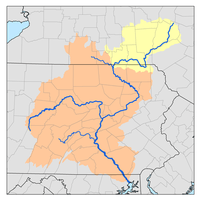Manada Creek
Manada Creek[1][2][3] is a 17.0-mile-long (27.4 km)[4] tributary of Swatara Creek in Dauphin County, Pennsylvania in the United States. The watershed drains approximately 32 sq mi (83 km). The name is derived the Lenape word "menatey", meaning "island".[5]
| Manada Creek | |
|---|---|
 View of the creek from the Jonestown Road Bridge at Manada Hill, Pennsylvania. | |
| Location | |
| Country | United States |
| State | Pennsylvania |
| Counties | Dauphin, Lebanon |
| Cities | Sandbeach, Manadahill, Manada Gap, Fort Indiantown Gap |
| Physical characteristics | |
| Source | Fort Indiantown Gap |
| • location | East Hanover Township, Lebanon County, Pennsylvania, USA |
| • coordinates | 40°26′29″N 76°38′41″W |
| Mouth | Swatara Creek |
• location | Sand Beach, Dauphin County, Pennsylvania, USA |
• coordinates | 40°18′16″N 76°40′08″W |
• elevation | 348 ft (106 m) |
| Length | 17.0 mi (27.4 km) |
| Basin size | 32.2 sq mi (83 km2) |
| Discharge | |
| • location | Manada Gap, Pennsylvania |
| • average | 23 cu ft/s (0.65 m3/s) |
| • minimum | 8 cu ft/s (0.23 m3/s) |
| • maximum | 987 cu ft/s (27.9 m3/s) |
| Basin features | |
| Tributaries | |
| • left | Walnut Run |
Course
The creek is born in Blue Mountain at Fort Indiantown Gap, East Hanover Township by the confluence of several branches, flowing southwest. The gap through the mountains which it flows through is known as Manada Gap. Later, it becomes the border of East Hanover and West Hanover townships, continuing to wind through forests and agricultural farmland before spilling into the Swatara Creek along the outskirts of the unincorporated community of Sand Beach.
The tributary Walnut Run joins Manada Creek in East Hanover Township.
Variant names
The stream was known originally as Monody Creek.[6][7][8] Several variant names not included by the Geographic Names Information System, but have been recorded through various sources:
See also
References
- Topographical Map
- Feature Detail Report for: Manada Creek
- Manada Creek Watershed
- U.S. Geological Survey. National Hydrography Dataset high-resolution flowline data. The National Map, accessed January 17, 2019
- The History of Dauphin County
- George P. Donehoo. "A History of the Indian Villages and Place Names in Pennsylvania". Retrieved 2019-04-26.
- Native American Placenames of the United States Bright, William. University of Oklahoma Press, 2004
- Indian Placenames in America, Volume 1 Nestor, Sandy. McFarland, 2015
External links
- Manada Conservancy
- Community Organizations
- U.S. Geological Survey: PA stream gauging stations
- USGS 01573482 Water Data - Manada Creek at Manada Gap, PA
- Indian Names data chart
- "Chapter 4"
